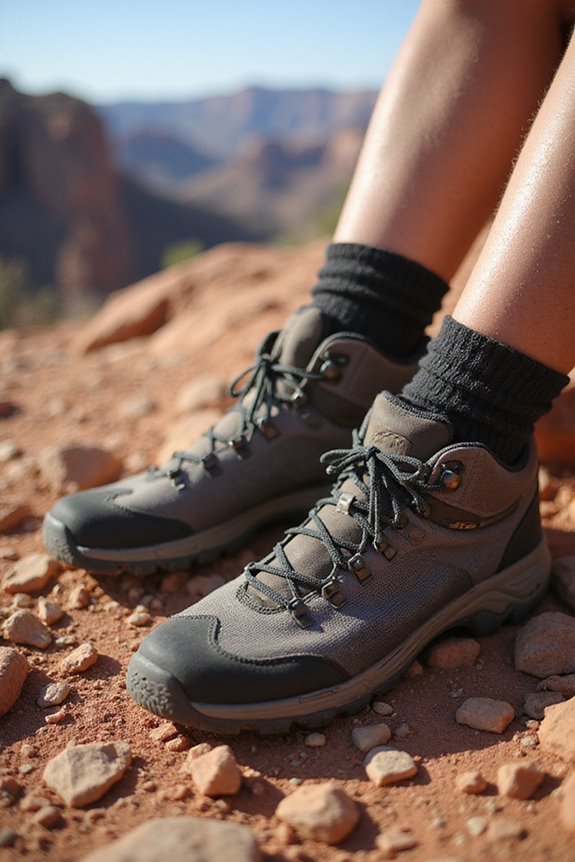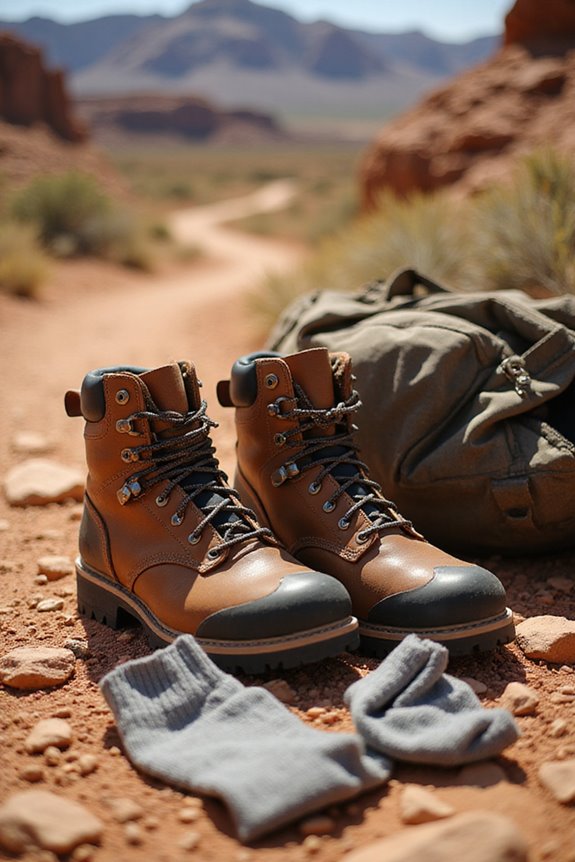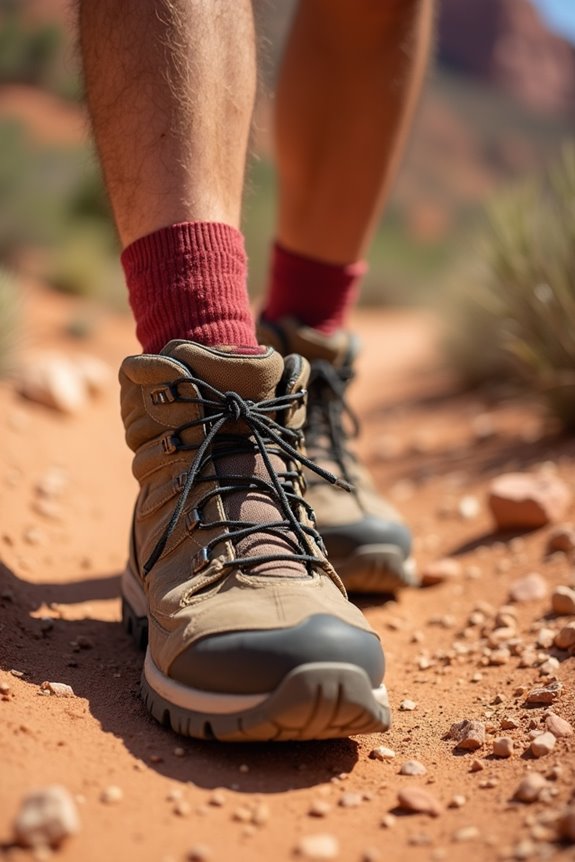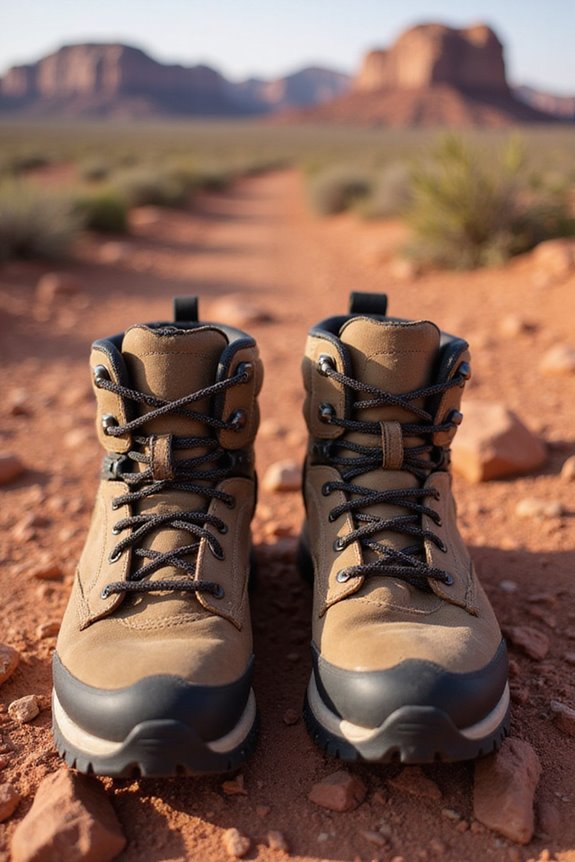When we gear up for our hikes, we can’t underestimate the importance of our socks—they can make or break our adventure! We love Merino wool for its soft, moisture-wicking magic that keeps our feet cozy and blister-free, and let’s not forget about the durability of synthetic blends that dry quickly. Trust me, ditch those cotton socks; they just can’t handle the heat—literally! Stick with the right materials, and you’ll be ready to tackle any trail. Want to find the perfect pair?
Key Takeaways
- Look for socks made from a blend of Merino wool and synthetic fibers for optimal moisture management and temperature regulation.
- Opt for reinforced toe and heel areas to enhance durability on rugged terrains and prevent wear and tear.
- Choose sock thickness according to the season: lighter for summer hikes and thicker for winter adventures.
- Ensure a snug fit to prevent bunching and blisters, enhancing overall comfort during long hikes.
- Consider lightweight synthetic options for fast drying and added breathability, especially in warm or humid conditions.
Essential Materials for Optimal Hiking Socks
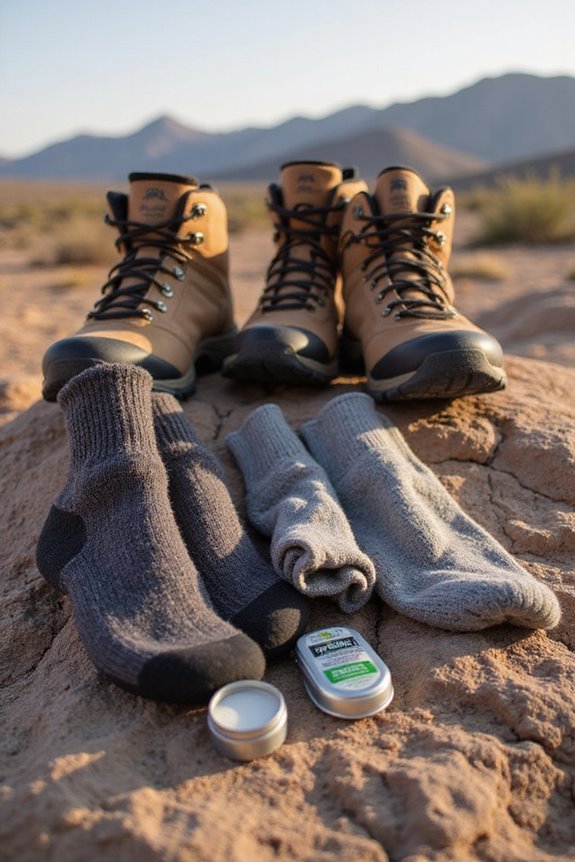
When it comes to hiking socks, choosing the right materials is like picking the perfect trail—crucial for an awesome adventure! It’s understood that merino wool reigns supreme with its temperature regulation and cushioning. It keeps our toes toasty without overheating, and its natural antimicrobial properties help us avoid that “hiker smell.” But let’s not forget about sock thickness; a blend of wool and synthetic fibers offers the best moisture management, ensuring our feet remain dry and comfy! Synthetics like polyester and nylon dry quickly and boost durability. Who doesn’t love a sock that can stand up to those muddy trails? Proper cushioning around the heel and arch enhances stability during hikes on rugged terrain. So, let’s gear up right—our feet deserve the best on every journey! Ready to hit the trails?
Key Features to Look for in Hiking Socks
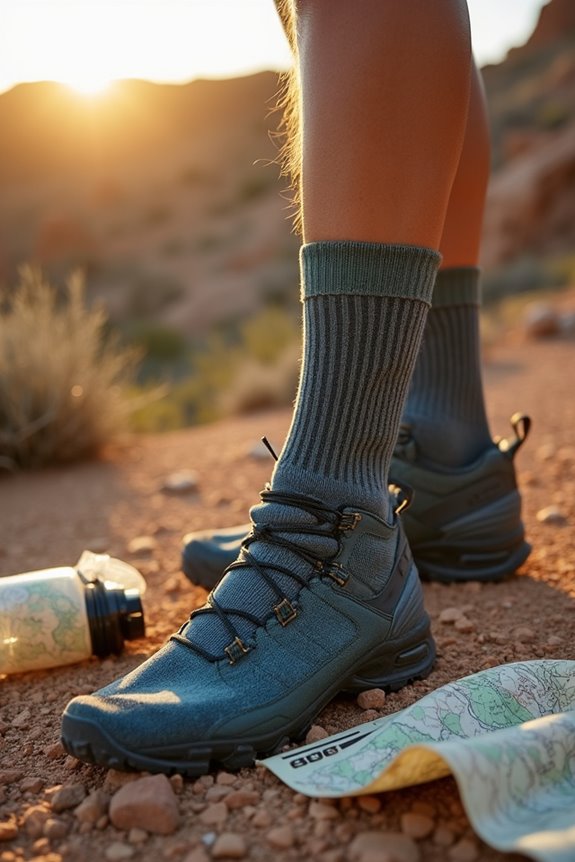
Choosing the right hiking socks can make the difference between a killer day on the trails and a foot-dragging disaster, so let’s plunge into the key features we should consider!
First off, sock thickness matters—lighter socks are great for summer hikes, while thicker ones shine in the winter. Now, let’s talk cushioning levels! We all know that comfortable cushioning reduces impact and fatigue, especially on rugged terrains.
And don’t forget about fit! A snug sock prevents bunching and blisters. Plus, reinforced toe and heel areas give us durability on those long treks. For challenging wet conditions, consider investing in socks with waterproof membranes that block moisture while maintaining breathability. Ultimately, our feet deserve the best, so let’s choose wisely and keep our adventures footloose and fancy-free! Happy hiking!
Advantages of Merino Wool for Hikers
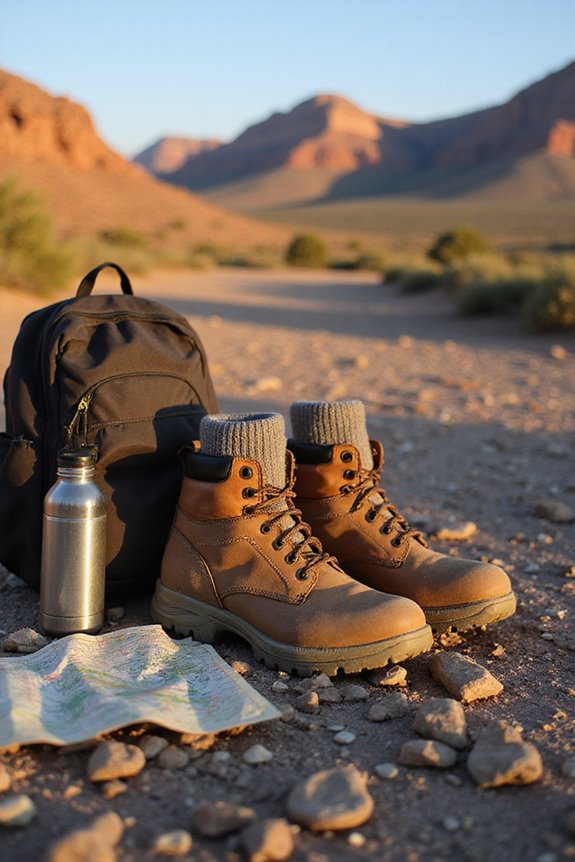
Hiking socks can make or break our trail experience, and when it comes to wisely choosing them, Merino wool stands out as an exceptional choice. With its amazing Merino advantages, we’re treated to superior hiking comfort. These fine, soft fibers hug our feet snugly and prevent blisters—no one wants hot spots ruining a perfect trek!
The moisture-wicking magic keeps our feet dry, even on those sweaty summer hikes. Plus, Merino wool acts like a natural thermostat, keeping our toes warm when it’s cold and cool when it’s hot. And let’s not forget about odor resistance; we can wear them a couple of days in a row without any funky smells. Similar to MERIWOOL base layers, merino hiking socks maintain their shape and softness with proper care while providing all-day comfort without any itchiness. So, let’s embrace Merino wool and hit the trails with confidence!
Why Cotton Socks Should Be Avoided
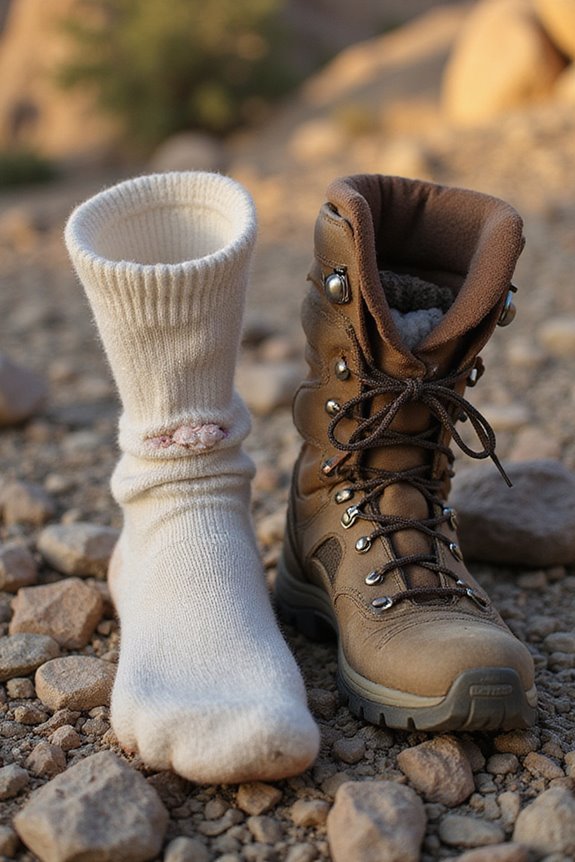
While we may have fond memories of slipping on a pair of soft cotton socks, it’s time to face the trail truth: cotton socks simply shouldn’t be part of our hiking gear. What are the cotton drawbacks? First off, they absorb moisture like a sponge, and once wet, they cling to our feet, creating blisters and chills. Yikes!
And let’s not even talk about odor—trust me, no one wants to be the hiker with stinky feet. Cotton’s inability to wick away moisture leads to discomfort, skin irritation, and potential fungal infections.
When we’re on the trail, we want to feel free, not bogged down by soggy cotton! So let’s ditch those cotton socks and step up our game with something better for our adventures! Instead, consider Merino wool socks which provide excellent moisture-wicking properties while keeping feet dry and comfortable during outdoor activities.
Benefits of Synthetic Materials in Hiking Socks
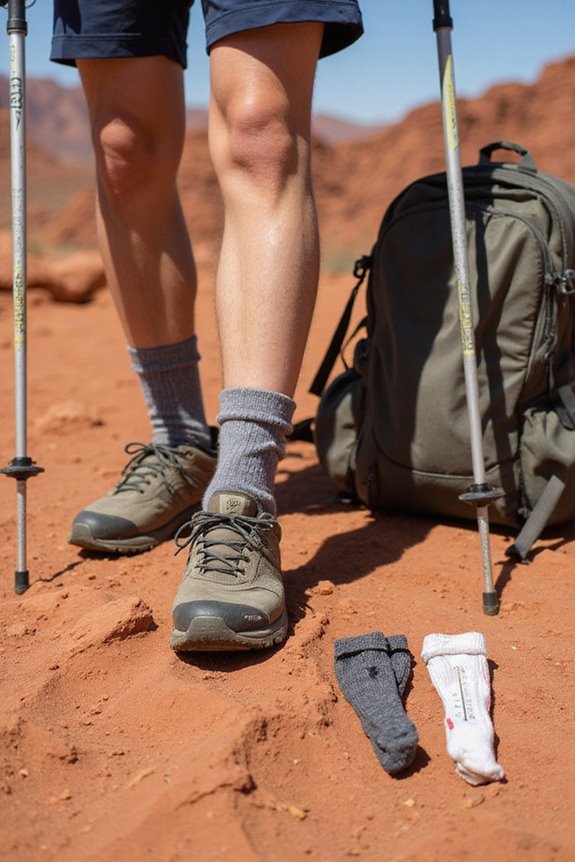
When we think about hitting those rugged trails, it’s all about finding the right gear. That’s where the synthetic advantages of hiking socks come into play! Made from materials like polyester and nylon, these socks excel in moisture management, wicking sweat away and keeping our feet dry. No one wants soggy feet on a long hike, right? Plus, they dry super fast—bye-bye blisters! Look for socks with ventilation channels that enhance airflow and provide a cooling effect during strenuous hikes. Synthetic socks are durable too, holding up against rough terrains and endless miles. And let’s not forget about comfort; they’re lightweight and breathable, perfect for regulating foot temperature during those epic climbs. So, gear up with synthetic, and let’s blaze those trails without a care in the world! Happy hiking!
Choosing Socks Based on Hiking Type and Duration
Choosing the right hiking socks can make or break our adventure out on the trails. For day hikes, we want lightweight socks that breathe and wick moisture, keeping our feet happy over those short distances. Now, for backpacking, we should reach for medium to heavy-weight socks with thick cushioning to absorb the impact of heavy loads on a multi-day trek—our feet will thank us!
On the other hand, if we’re tackling winter trails, thicker merino wool socks are essential for warmth and protection. Let’s not forget about trail running! Those lightweight socks with minimal cushioning can help us race through rugged paths, keeping blisters at bay. So, let’s pick our socks wisely and embrace the freedom of the great outdoors!
Tips for Maintaining and Caring for Hiking Socks
To keep our hiking socks in top shape, it’s essential we treat them like the trail buddies they are. We should wash our socks with a gentle detergent and avoid fabric softeners like the plague. Trust us, they mess with sock fibers, leading to heartbreak on the trail. Turning them inside out before washing can work wonders for cleanliness!
Once washed, let’s air-dry them flat—no twisting or wringing, please! It’s all about sock longevity tips. If we’re on multi-day hikes, airing them out between uses is brilliant. Plus, more is merrier—rotate those socks to keep them fresh. Following these washing frequency guidelines will keep our feet happy and blisters at bay. Happy hiking, friends!
Frequently Asked Questions
How Often Should I Replace My Hiking Socks?
When it comes to hiking sock durability, we should replace them regularly. For frequent hikes, let’s aim for yearly replacements, while those hitting the trails harder might want to contemplate every 8–12 months.
Can I Wear Two Pairs of Socks While Hiking?
Research shows that wearing two pairs of socks can reduce blister risk by up to 80%. We love sock layering for enhanced comfort levels, especially on long treks where our feet deserve the best protection and support.
Are Toe Socks Beneficial for Hiking?
We’ve found that toe socks offer fantastic blister prevention, enhancing toe separation and airflow. Their advantages lead to improved balance and comfort, making our hiking experience freer and more enjoyable, even on long trails.
What’s the Best Way to Wash Hiking Socks?
A stitch in time saves nine! When it comes to sock care, we should always use gentle washing techniques, like hand washing in lukewarm water, to preserve our hiking socks’ performance and extend their lifespan.
Should I Size up for Thicker Hiking Socks?
When considering sock thickness, we should definitely size up for thicker hiking socks. It guarantees our foot comfort isn’t compromised, allowing us to roam freely without pinching or cramping on the trails. Comfort is everything!

